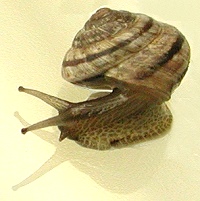Invertebrate
Zoology Mollusca
Most invertebrates have an impact on humans, but members of the Phylum Mollusca have a particularly strong influence on us because of their edibility and beauty. At times throughout human history, molluscs were the primary food source for whole civilizations (for example, Native Americans living on the Pacific coast consummed large quantities of abalone). Today we eat molluscs in the form of escargot, calamari, clams casino, and oysters on the half shell. Bivalves create pearls and shells that are used to make jewelry; mother-of-pearl is used to make buttons. Experimentation with the squid giant axon was pivotal in the advancement of our understanding of how the nervous system works.
On the other hand, the relationship is not always positive. Snails are intermediate hosts for medically important human flukes such as Clonorchis and Schistosoma. Slugs are nuisances in gardens and shipworms bore into ships and piers. Zebra mussels have invaded the great lakes with many negative impacts, including changing the food web and degrading fish habitats.
 |
Phylum Mollusca
1.
Body of two parts: head-foot and visceral
mass
2.
Mantle that secretes a calcareous
shell and covers the visceral mass
3.
Mantle cavity functions in excretion,
gas exchange, elimination of digestive wastes, and release of reproductive
products
4.
Bilateral symmetry
5.
Protostome characteristics, including
trochophore larvae, spiral cleavage, and
schizocoelous coelom
formation
6.
Coelom reduced to cavities surrounding
the heart, nephridia, and gonads
7.
Open circulatory system in all but
one class (Cephalopoda)
8.
Radula usually present and
used in scraping food |
Molluscs range in size and body form from the giant squid, measuring 18 meters in length,
to the smallest garden slug, less than one centimeter long. Molluscs have invaded nearly every type of freshwater and marine habitat (including hydrothermal vents), as well as numerous terrestrial habitats. The divergence of body forms and lifestyles within the phylum Mollusca is an excellent example of adaptive radiation—the diversification of a numerous species from a common ancestor following migration into different environments. Molluscs began as slow-moving, bottom-dwelling marine grazers, but the evolution of unique molluscan characteristics allowed them to diversify relatively quickly. The change from grazing to other forms of food aquisition is one of the major features in the radiation of molluscs. Most of today's living molluscs are gentle vegetarians, some are sedentary filter feeders, and others are active predators.
Any collection of animals that includes members as diverse as snails, oysters, mussels, squids and octopuses presents a challenge when it comes to identifying general features that link them all together. There are only three characteristics shared by all living molluscs: the head-foot, visceral mass, and mantle.
The head-foot is an anterior head containing the mouth and nervous and sensory structures; an elongate, muscular foot is used for locomotion. In cephalopods, the foot has becomes modified into a bundle of arms and tentacles for grabbing and handling prey.
The visceral mass is usually located dorsal to the head-foot. It houses the organs of digestion, circulation, reproduction, and excretion.
The mantle is perhaps the most unique feature of molluscs. The mantle is a sheet of tissue that usually attaches to the visceral mass, enfolds most to the body, and may secrete a shell. Between the mantle and foot is a space called the mantle cavity. It opens to the outside and functions in gas exchange, excretion, elimination of digestive wastes, and release of gametes. It may function as a brood chamber for larval development.
A calcium carbonate shell is present in most molluscs and is often the most recognizable feature of the phylum. All of the major classes of molluscs have at least some members with a shell. In one case, the cephalopods, the shell is not a prominent feature: squids have only an internal reminant of a shell and octopuses have lost the shell altogether. (Click on link below to see the features of the major molluscan classes.)
The mouth of many molluscs have a specialized feeding structure known as the radula. This tongue-like device with a conveyer-belt of tiny teeth is a unique feature of molluscs. It is especially prominent in gastropods, chitons and cephalopods. Predatory snails in the genus Conus have an extreme example of a radula that is modified into a harpoon-like device to inject toxin.